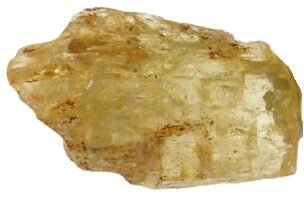
Golden apatite, a mineral of striking allure and enduring mystique, captivates collectors, geologists, and spiritual practitioners alike. This article meticulously examines the origins of its name, its alternate denominations, composition, physical properties, and varieties; explores geographical locations of occurrence; and details archaeological finds, historical and modern usages. Furthermore, it delves into intriguing folklore, mystical healing properties, astrological connections, chakra associations, and its recognised roles as a birthstone and a wedding anniversary gemstone.
Origins of the Name and Alternate Denominations
Golden apatite derives its name from the Greek word apatein, meaning “to deceive”, which alludes to its capacity to mimic other minerals in appearance. Alternate names such as “phosphate ore” and “fluoroapatite” are prevalent in mineralogical literature. The nomenclature reflects its chemical nature as a phosphate mineral, often containing fluorine, chlorine, or hydroxyl groups.
Composition, Physical Characteristics, and Varieties
Golden apatite exhibits a robust crystalline structure, predominantly composed of calcium phosphate. Its typical formula, Ca₅(PO₄)₃(F,Cl,OH), underscores a complex chemical framework. The mineral manifests in a golden hue due to trace impurities, frequently ranging from pale yellow to deep amber. Its lustrous appearance, moderate hardness, and distinct cleavage planes contribute to its widespread appeal. Varieties include fluorapatite, chlorapatite, and hydroxylapatite, each demonstrating subtle variations in composition and brilliance.
Geographical Occurrences
Golden apatite appears in diverse geological settings worldwide. Brazil, Madagascar, and South Africa hold significant deposits, while North America and Europe yield notable occurrences in sedimentary and igneous formations. Its widespread presence and varied origins highlight its importance as both a decorative stone and a subject of scientific study.
Archaeological Significance and Historical Usage
Archaeologists have uncovered golden apatite in artefacts and ritual objects dating back millennia. Civilisations across Africa, Asia, and the Americas prized the stone for ornamentation and ceremonies. Historical records highlight its valued role in early human traditions, where people admired its vibrant hue in jewellery and talismans. Today, golden apatite continues to attract attention for both its aesthetic beauty and its claimed metaphysical properties.
Interesting Facts and Curiosities
Golden apatite fascinates with its vibrant colour and strong link to energy and creativity. Many mistake it for other minerals due to its deceptive appearance, reflecting the origins of its name. Its uses range from industrial phosphates to alternative healing, drawing interest across multiple disciplines.
Folklore, Legends, and Tales
Legends enshroud golden apatite in an aura of mysticism. Folklore suggests that the stone harbours protective powers, capable of dispelling negative energies and misfortunes. Ancient tales recount its use as a symbol of enlightenment and prosperity. These narratives have pervaded cultural traditions, imbuing the mineral with a narrative that transcends its geological origin.
Mystical Healing Properties
The mystic properties of golden apatite are deeply embedded in alternative healing practices. Advocates assert that the stone stimulates mental clarity, enhances communication, and aids in the alleviation of stress. Its vibrational energy is said to foster emotional balance and invigorate the body’s natural healing mechanisms. Such properties continue to attract individuals seeking holistic wellness solutions.
Astrological Associations and Zodiac Links
Golden apatite holds a prominent place within astrological paradigms. It is reputed to align with the energies of zodiac signs such as Leo and Sagittarius, whose fiery dispositions resonate with the stone’s luminous characteristics. Practitioners of astrology and gemstone therapy incorporate golden apatite into rituals designed to enhance personal power and self-expression.
The Chakra System
Within the chakra system, golden apatite is believed to stimulate the solar plexus chakra. This energy centre governs personal will, power, and confidence. By harmonising and activating the solar plexus, the stone purportedly facilitates clarity of purpose and emotional stability, thereby contributing to an individual’s spiritual and physical equilibrium.
Gemstone Use: Birthstone and Wedding Anniversary
In the realm of gemstones, golden apatite occupies a distinguished niche as a birthstone for those born under specific astrological influences. It is also revered as a commemorative stone for wedding anniversaries, symbolising enduring love and shared prosperity. Its radiant hue and intricate energy continue to render it a popular choice for bespoke jewellery and celebratory gifts
